Matcha
Matcha vs. Coffee: Are They Similar in Taste & Energy?
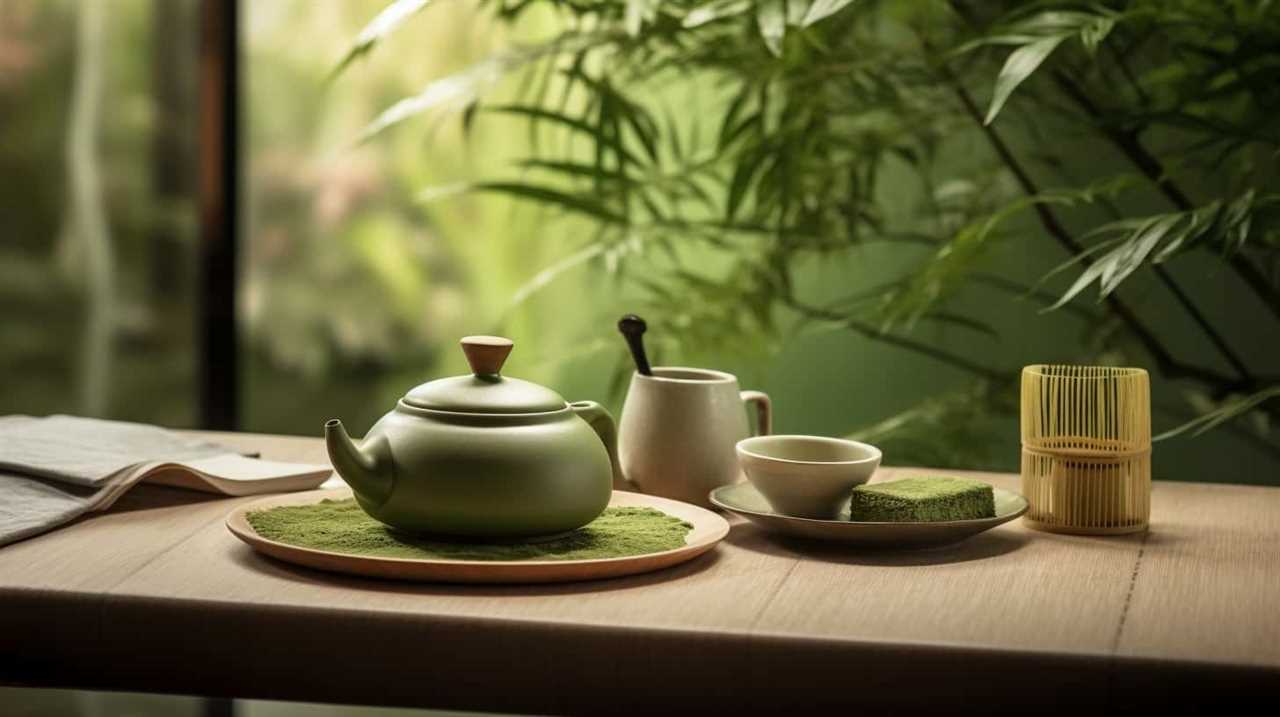
Are you curious about the similarities between matcha and coffee? Well, you may be surprised to learn that matcha, a vibrant green powdered tea, shares some intriguing qualities with coffee.
In this exploration, we will delve into the origins, taste profiles, caffeine content, processing methods, health benefits, and cultural significance of both matcha and coffee. By examining these aspects, we can gain a deeper understanding of how these beverages can complement our daily routines.
So, let’s embark on this journey to unravel the mysteries of matcha and coffee and discover the unique characteristics that make each of them a delightful and invigorating beverage.
Key Takeaways
- Matcha and coffee have different origins and processing methods, with matcha being made from shaded tea plants and coffee being extracted from dried and roasted coffee beans.
- Matcha has an earthy and slightly sweet taste with a rich and smooth texture, while coffee has a bolder and more robust flavor, described as bitter, nutty, or fruity.
- Matcha typically contains less caffeine than coffee, with matcha having about 35 milligrams of caffeine per eight-ounce serving and coffee having about 95 milligrams.
- Matcha is rich in antioxidants, specifically catechins, while coffee is known for its energy-boosting effects due to caffeine. Both can have positive effects on brain function and metabolism when consumed in moderation.
Origins of Matcha and Coffee
The origins of matcha and coffee differ significantly in terms of their cultivation, processing, and cultural significance.
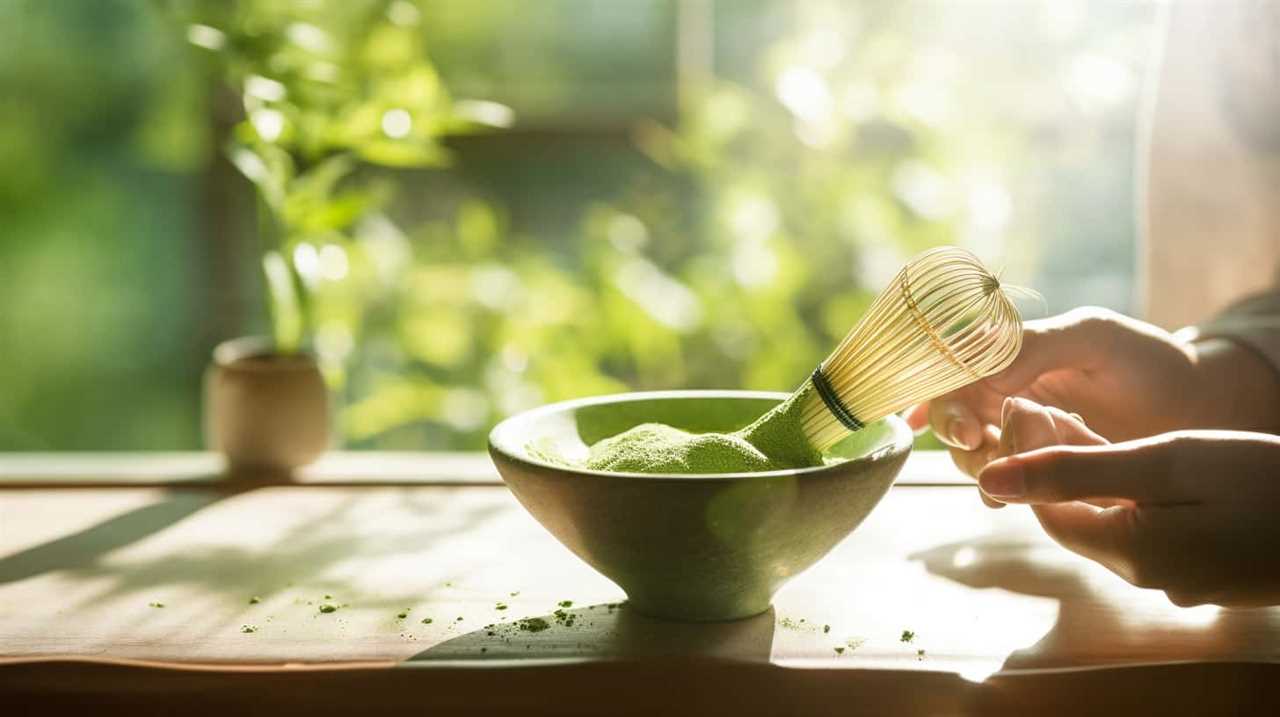
Matcha, a powdered green tea, has its roots in ancient China during the Tang Dynasty (618-907 CE). It was later introduced to Japan by Buddhist monks in the 12th century. The cultivation of matcha involves shading the tea plants for several weeks before harvest to enhance the production of chlorophyll and amino acids. The leaves are then carefully hand-picked, steamed, dried, and ground into a fine powder.
On the other hand, coffee originated in Ethiopia and has a long history dating back to the 9th century. The coffee plant is grown in tropical regions and the beans are extracted from the cherry-like fruit, dried, roasted, and ground before brewing.
The cultural significance of matcha lies in its association with traditional Japanese tea ceremonies, while coffee has become a popular beverage worldwide with its own unique cultural rituals and social gatherings.
Differences in Taste Profile
When it comes to taste, matcha and coffee offer distinct flavor profiles that set them apart from each other.
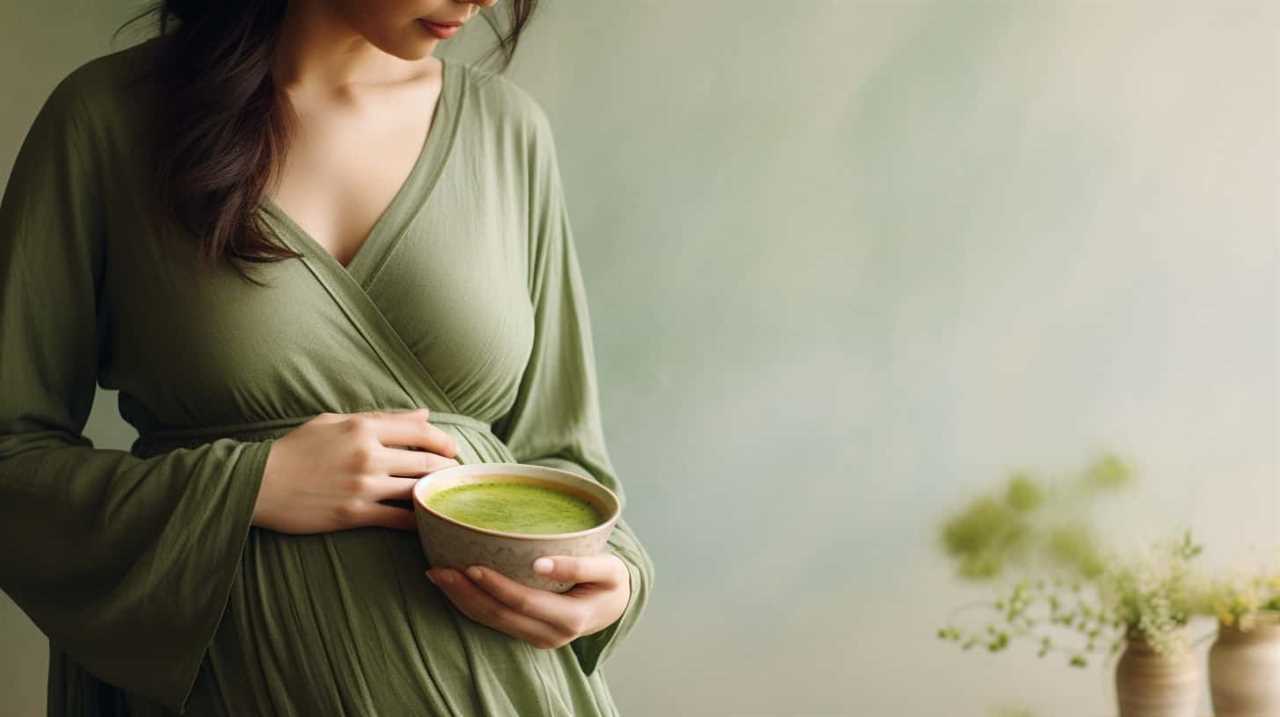
Matcha has a unique taste that can be described as earthy, grassy, and slightly sweet. It has a rich and smooth texture that coats the palate.
On the other hand, coffee has a bolder and more robust flavor, often described as bitter, nutty, or even fruity, depending on the roast and origin of the beans. The aroma of matcha is fresh and vegetal, while coffee has a strong and intoxicating aroma that can be both invigorating and comforting.
In terms of brewing methods, matcha is prepared by whisking the powdered tea with hot water, creating a frothy and creamy texture. Coffee, on the other hand, is brewed using various methods such as pour-over, French press, or espresso, resulting in different flavors and intensities.
The taste profiles of matcha and coffee are distinct, allowing individuals to choose the flavor that suits their preferences.
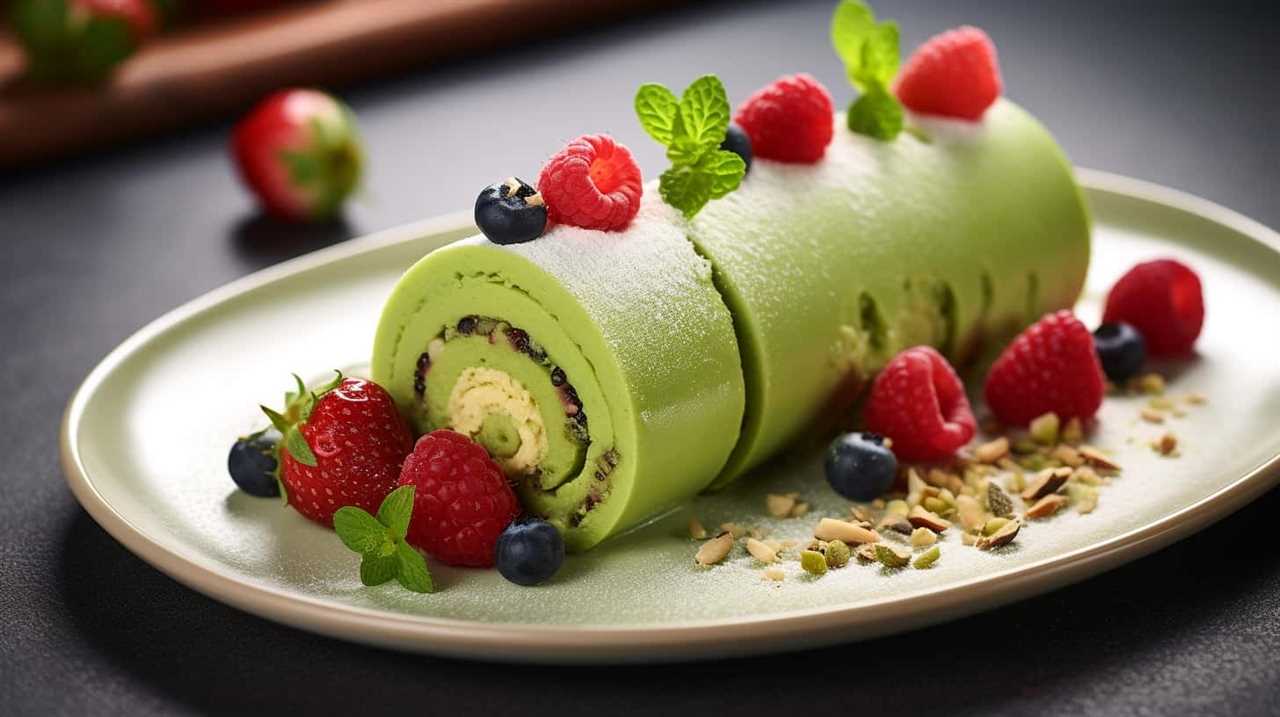
Comparison of Caffeine Content
As we delve into the comparison of caffeine content between matcha and coffee, it’s important to note how frequently individuals consume these beverages.
Caffeine is a natural stimulant found in both matcha and coffee, and its effects vary depending on the amount consumed. Matcha, a powdered green tea, typically contains less caffeine than coffee.
While the exact caffeine content can vary based on factors such as brewing method and serving size, on average, matcha contains about 35 milligrams of caffeine per eight-ounce serving, while coffee contains about 95 milligrams.
It’s worth noting that caffeine can have both positive and negative effects on the body. While it can help improve alertness and focus, excessive consumption of caffeine can lead to side effects such as increased heart rate, jitteriness, and difficulty sleeping.
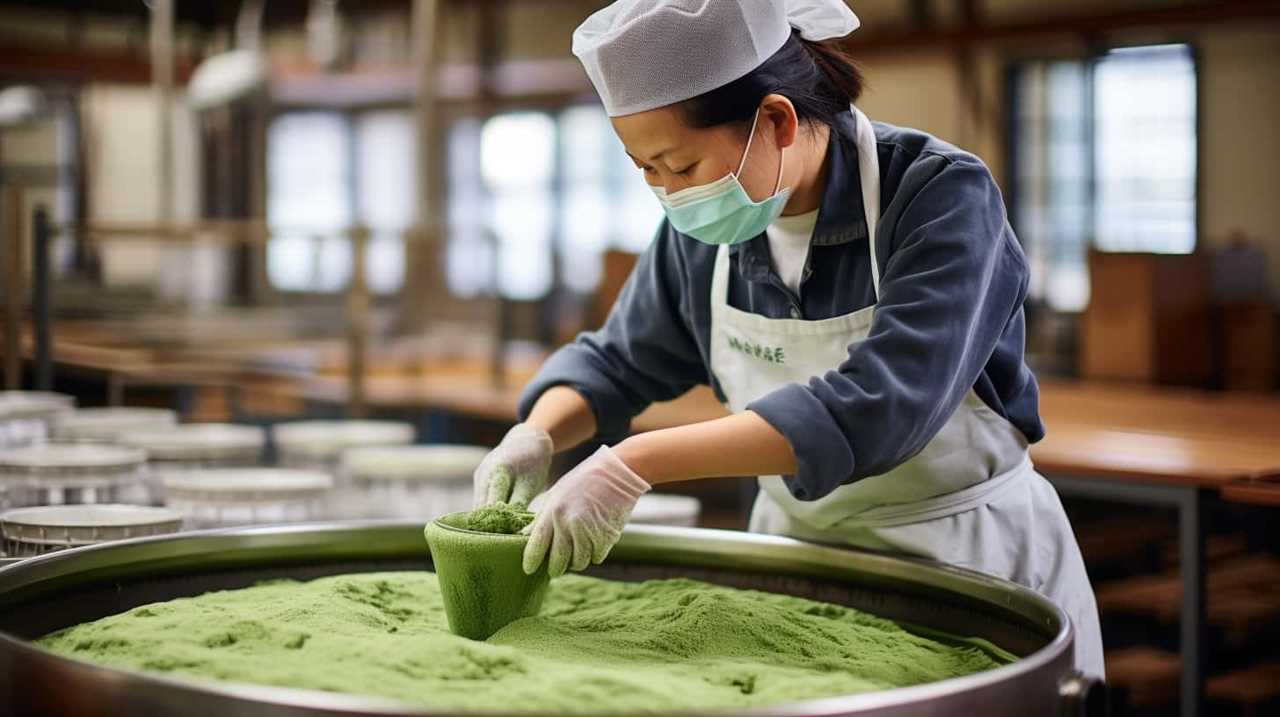
Additionally, long-term excessive caffeine intake may have negative health impacts, including increased risk of cardiovascular disease and gastrointestinal issues. Therefore, moderation is key when consuming beverages containing caffeine.
Processing Methods of Matcha and Coffee
One key difference between matcha and coffee is the processing methods used for each beverage. Understanding the processing techniques can shed light on the distinct flavor profiles of matcha and coffee. Here are four important points to consider:
- Matcha: Matcha is made from shade-grown tea leaves that are carefully handpicked. The leaves are then steamed, dried, and ground into a fine powder. This meticulous process helps to retain the vibrant green color and the unique umami flavor of matcha.
- Coffee: Coffee beans go through a completely different process. They’re harvested, washed, and dried before being roasted to bring out their distinct flavors. The roasting process can vary, resulting in different flavor profiles, such as light, medium, or dark roast.
- Flavor Profiles: Matcha has a rich, vegetal taste with hints of sweetness and a smooth, creamy texture. On the other hand, coffee offers a wide range of flavors, including fruity, nutty, chocolatey, or floral notes, depending on the origin and roast level.
- Impact of Processing Techniques: The processing techniques used for matcha and coffee play a crucial role in shaping their flavor profiles. The careful cultivation and grinding of matcha leaves result in a concentrated and complex flavor, while the roasting of coffee beans brings out the aromatic compounds that give coffee its characteristic taste.
Understanding the processing methods of matcha and coffee allows us to appreciate the nuances of each beverage and choose the one that suits our preferences.
Health Benefits of Matcha and Coffee
When comparing the health benefits of matcha and coffee, there are a few key points to consider.
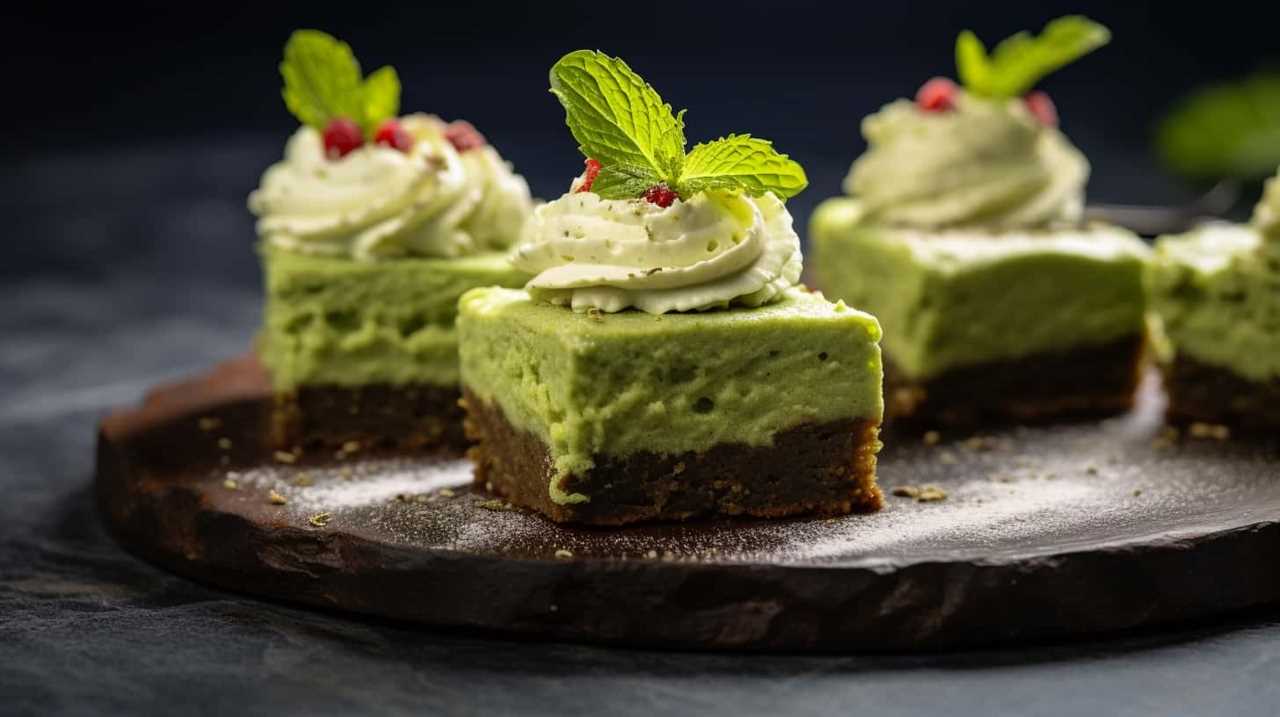
Firstly, in terms of energy levels, matcha provides a more sustained and gradual release of energy compared to the quick boost and subsequent crash often associated with coffee.
Additionally, matcha contains significantly higher levels of antioxidants, known for their potential to reduce inflammation and protect against chronic diseases.
These differences in energy levels and antioxidant content make matcha a potentially healthier alternative to coffee.
Energy Levels Comparison
In our experience, the energy levels provided by matcha and coffee differ significantly. Here are four key points to consider when comparing the energy levels of these beverages:
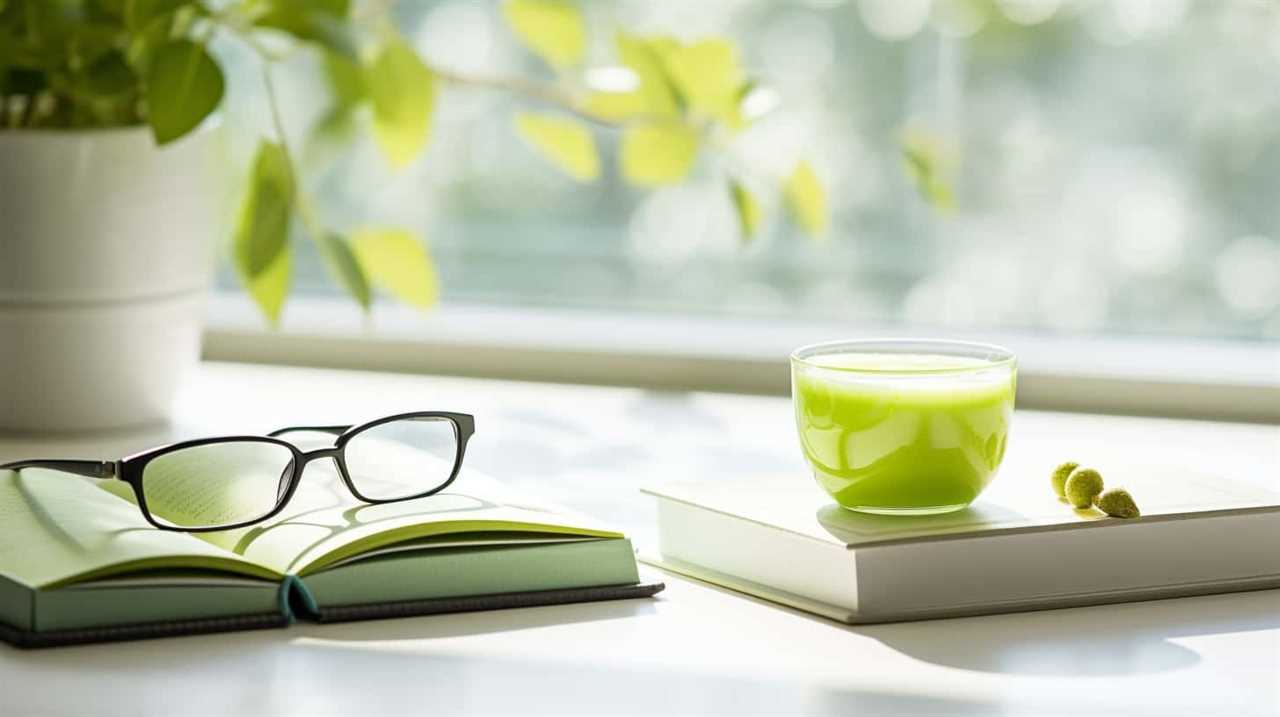
- Caffeine content: Matcha contains less caffeine than coffee, but it provides a more sustained release of energy. This is due to the presence of L-theanine, an amino acid that promotes relaxation without drowsiness.
- Antioxidant boost: Matcha is rich in antioxidants called catechins, which have been shown to improve energy levels and reduce fatigue. Coffee also contains antioxidants, but in lower quantities.
- Nutritional value: Matcha is a whole leaf green tea powder, meaning it retains more nutrients compared to coffee which is a processed bean. Matcha contains vitamins, minerals, and fiber, contributing to a healthier energy boost.
- Long-term effects: While coffee can lead to energy crashes and dependency, matcha provides a more stable and sustained source of energy. Matcha also has a calming effect, preventing the jitters and anxiety associated with coffee consumption.
Understanding these differences can help you make an informed choice when it comes to choosing the right beverage for your energy needs.
Antioxidant Content Difference
As we delve into the health benefits of matcha and coffee, it’s important to note the significant difference in their antioxidant content.
Antioxidants are compounds that help protect our cells from damage caused by harmful molecules called free radicals. They play a crucial role in maintaining overall health and preventing chronic diseases.
Matcha, a powdered form of green tea, is known to have high levels of antioxidants, particularly catechins. These powerful antioxidants have been linked to numerous health benefits, including reducing the risk of heart disease, improving brain function, and boosting metabolism.
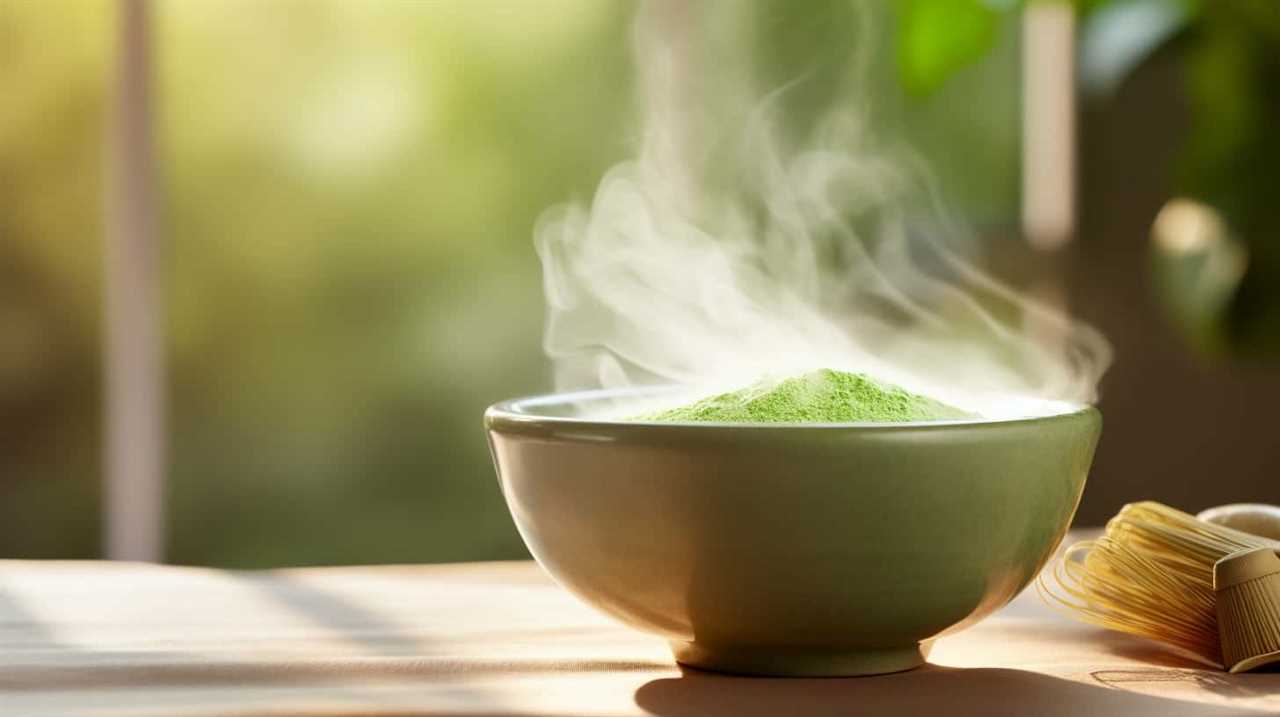
On the other hand, while coffee also contains antioxidants, the levels are generally lower compared to matcha. However, coffee still offers some antioxidant benefits and has been associated with a reduced risk of certain diseases like type 2 diabetes and liver disease.
Impact on Energy Levels
When comparing matcha and coffee, one important aspect to consider is their impact on energy levels.
Matcha contains caffeine, just like coffee, which can provide an energy boost.
However, matcha also contains other compounds that work together to provide a more sustainable and balanced energy increase, reducing the likelihood of a crash after consumption.
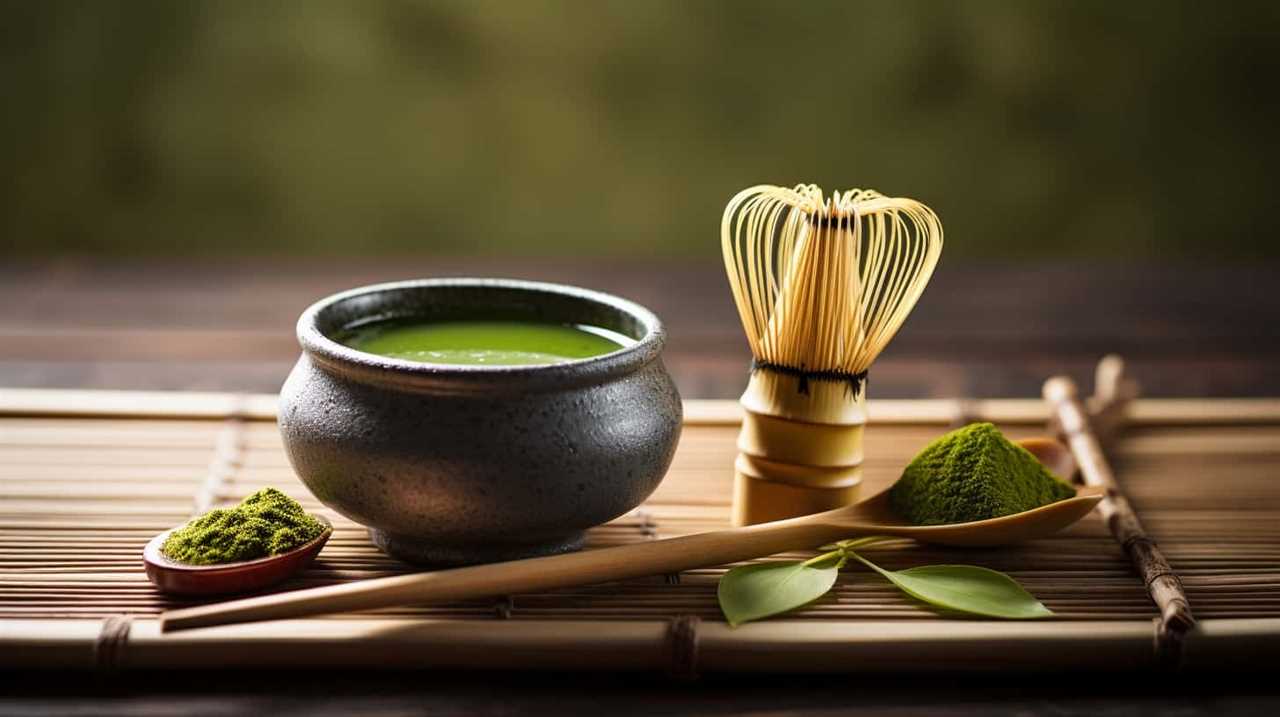
Understanding the differences in how matcha and coffee affect energy levels can help individuals make informed choices about their preferred source of energy.
Matcha Vs. Caffeine
Matcha and caffeine have distinct effects on our energy levels, making it important to understand the difference between the two.
Here are four key differences in caffeine absorption and effects on sleep patterns:
- Caffeine Absorption: Matcha contains caffeine, but it’s absorbed more slowly by the body compared to coffee. This slower absorption leads to a more sustained release of energy and prevents the jitters often associated with coffee consumption.
- L-Theanine Content: Matcha contains the amino acid L-theanine, which promotes relaxation and reduces anxiety. This can counterbalance the stimulating effects of caffeine and provide a state of calm alertness.
- Sleep Patterns: Consuming coffee close to bedtime can disrupt sleep patterns due to its higher caffeine content. Matcha, on the other hand, contains lower levels of caffeine and L-theanine, which can help promote a more restful sleep.
- Antioxidant Benefits: Matcha is known for its high antioxidant content, which can provide long-lasting energy without the crash associated with coffee.
Understanding the differences between matcha and caffeine can help individuals make informed choices about their energy levels and overall well-being.
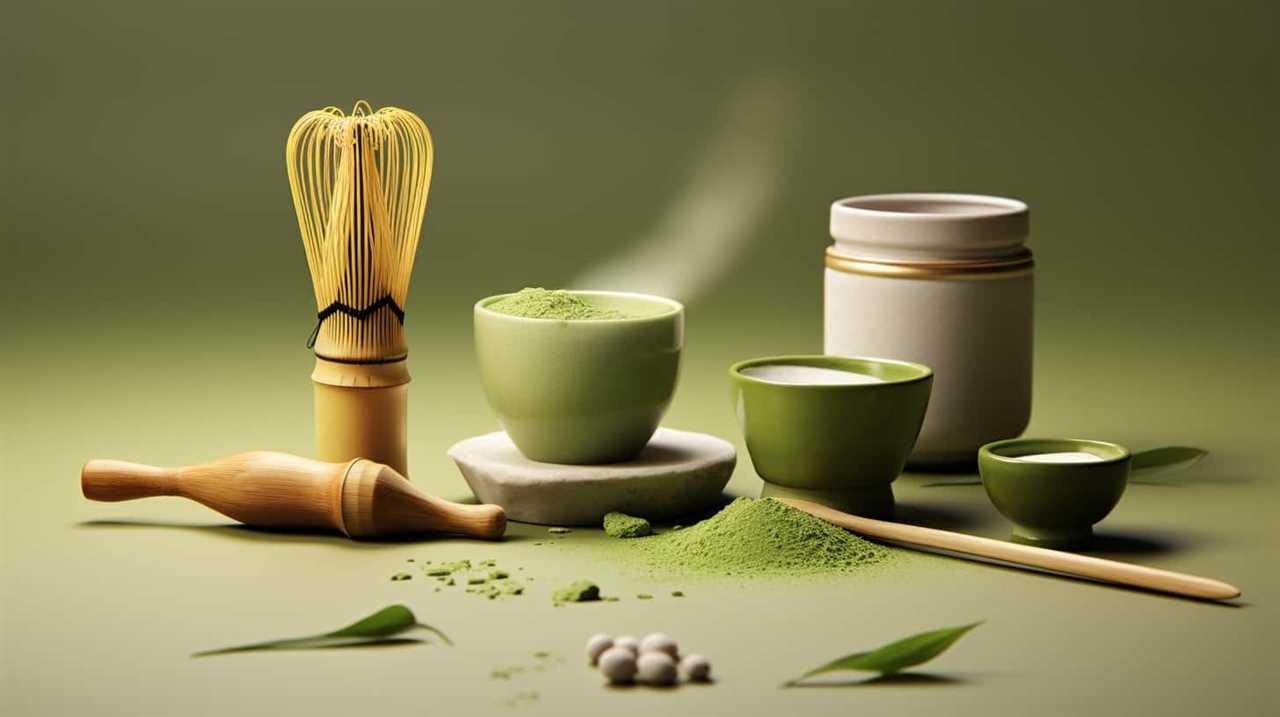
Sustainable Energy Boost
While matcha and coffee have different effects on our energy levels, matcha provides a sustainable energy boost throughout the day. Matcha is made from powdered green tea leaves, which contain a unique combination of caffeine and amino acids. This combination allows for a slower release of caffeine into the bloodstream, resulting in sustained energy levels without the jitters or crash commonly associated with coffee.
Additionally, matcha is often produced using sustainable farming practices, which have a positive environmental impact. Matcha plants are shade-grown, which requires less water and reduces the need for pesticides. The leaves are hand-picked and stone-ground, minimizing energy consumption during the production process.
Crash After Consumption?
After enjoying a sustained energy boost from matcha, we don’t experience the crash commonly associated with coffee. The crash after coffee consumption is a well-known phenomenon caused by the sudden drop in energy levels once the effects of caffeine wear off. However, matcha provides a more stable and sustained energy boost due to its unique combination of caffeine and L-theanine, an amino acid that promotes relaxation and focus. This combination helps to prevent the sudden energy crash often experienced with coffee. Additionally, matcha contains a lower caffeine content compared to coffee, which reduces the likelihood of experiencing jitters or a crash. Understanding the impact of matcha on energy levels is crucial when considering its long-term effects and overall benefits.
Now, let’s explore the nutritional value of matcha and coffee.
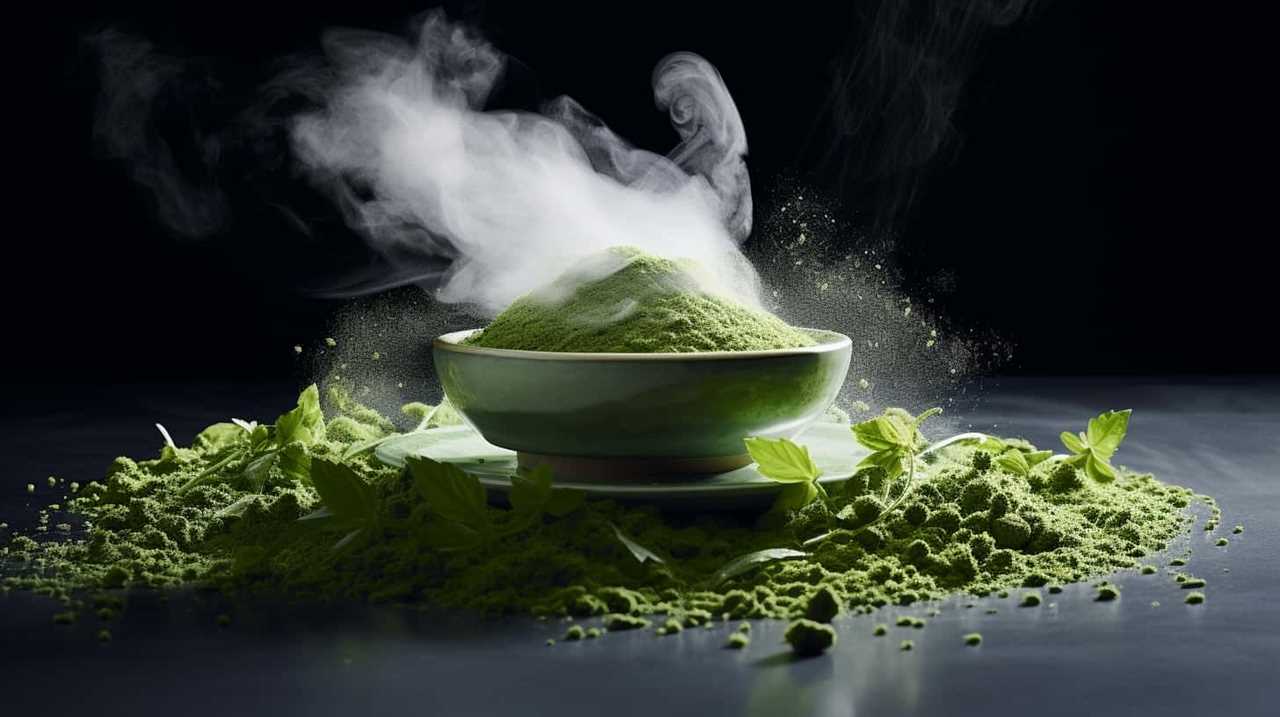
Nutritional Value of Matcha and Coffee
We can compare the nutritional value of matcha and coffee by examining their respective quantities of antioxidants, vitamins, and minerals. Matcha, a type of powdered green tea, is made from shade-grown tea leaves that are stone-ground, preserving its nutrients. On the other hand, coffee beans are roasted and ground before brewing. Both matcha and coffee contain antioxidants that help protect against free radicals and promote overall health. While matcha provides a higher concentration of antioxidants, coffee is a rich source of essential vitamins and minerals such as riboflavin, niacin, and magnesium. Here is a comparison of the nutritional value of matcha and coffee:
| Nutrient | Matcha | Coffee |
|---|---|---|
| Antioxidants | High | Moderate |
| Vitamins | Vitamin C | Riboflavin, Niacin |
| Minerals | Iron, Calcium | Magnesium |
Understanding the nutritional differences between matcha and coffee allows us to further explore their antioxidant properties.
Antioxidant Properties of Matcha and Coffee
When comparing the antioxidant properties of matcha and coffee, several points come to light.
Firstly, both matcha and coffee have health benefits due to their high antioxidant levels.
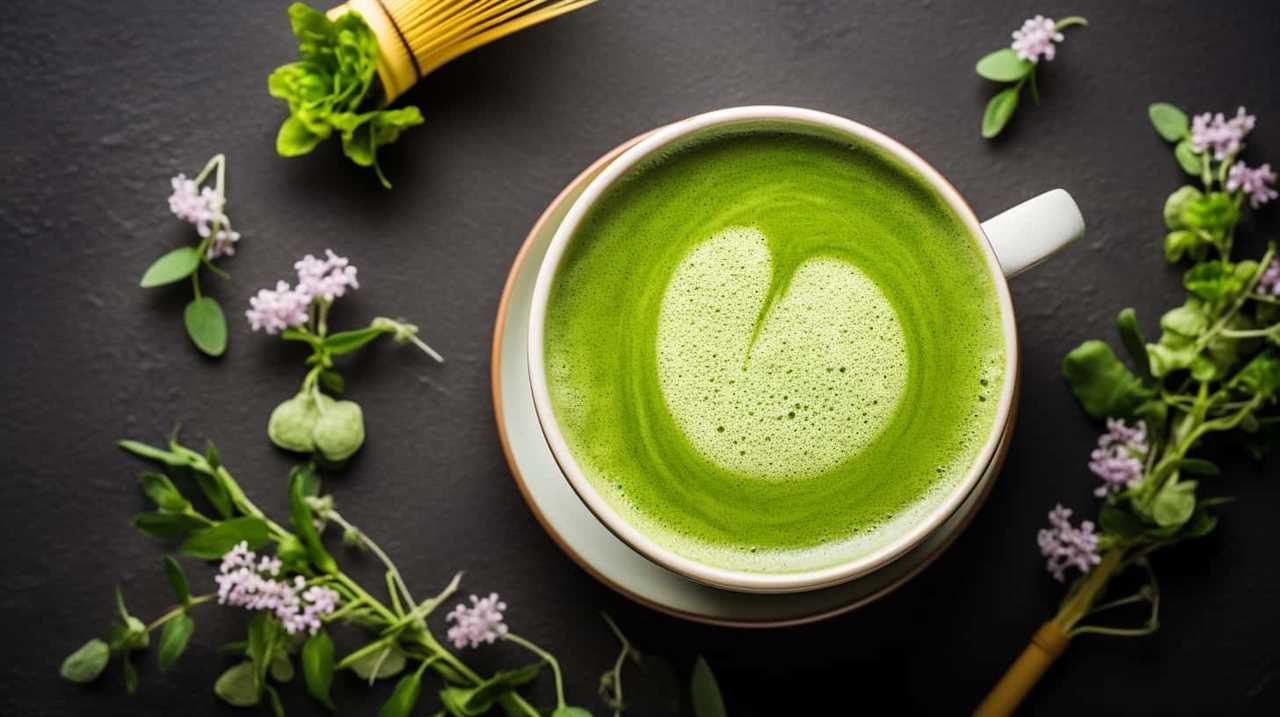
However, matcha surpasses coffee in terms of antioxidants, as it contains significantly higher levels of catechins and epigallocatechin gallate (EGCG).
Lastly, it’s worth noting that while matcha contains less caffeine than coffee, it still provides a slight energy boost without the jitters commonly associated with coffee consumption.
Health Benefits Comparison
The antioxidant properties of matcha and coffee can be compared to determine their respective health benefits.
When it comes to potential side effects, matcha is generally considered safe for consumption, while coffee may cause issues such as increased heart rate, anxiety, and disrupted sleep.
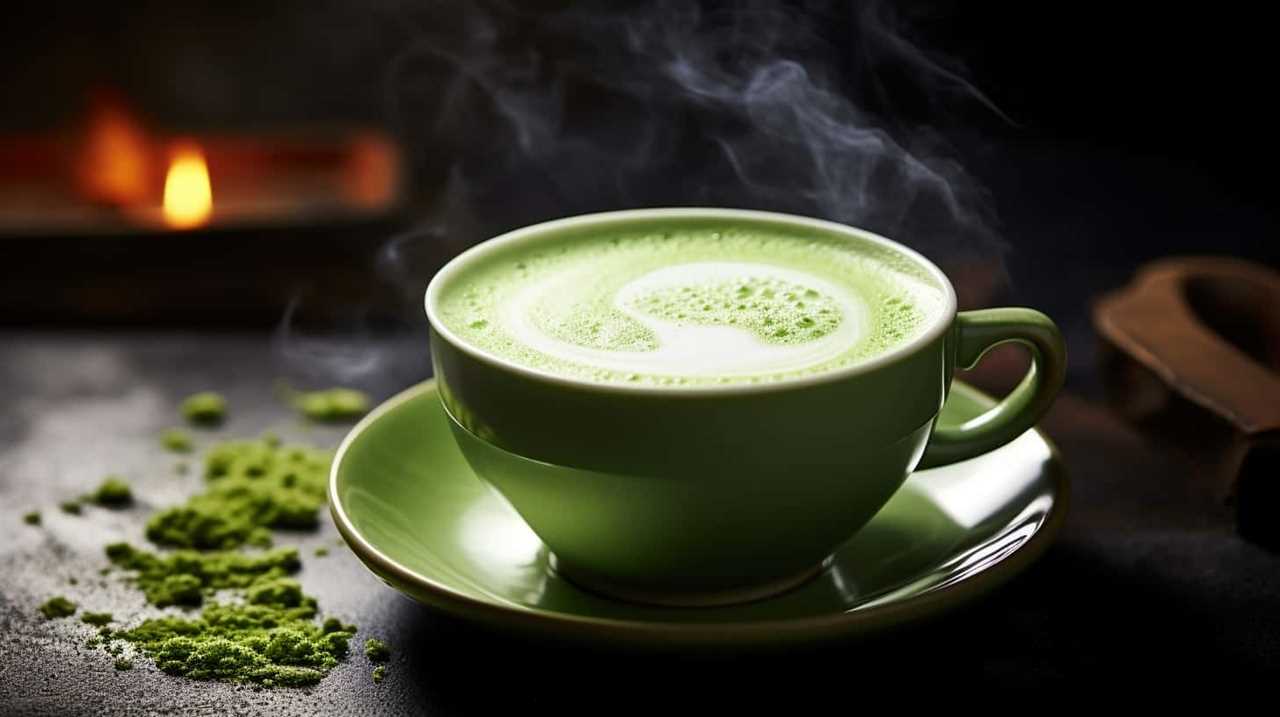
In terms of metabolism-boosting benefits, matcha contains a higher level of catechins, which have been shown to enhance fat oxidation and increase thermogenesis. Coffee, on the other hand, contains caffeine, which can also stimulate metabolism and improve exercise performance.
Additionally, both matcha and coffee are rich in antioxidants, which can help reduce inflammation and protect against chronic diseases.
However, it’s important to note that the specific health benefits of matcha and coffee may vary depending on individual factors such as dosage, preparation, and overall diet.
Antioxidant Levels Comparison
In the comparison of antioxidant levels, matcha and coffee exhibit varying properties.

Antioxidants are compounds that help protect the body against free radicals, which can cause damage to cells and contribute to various health issues.
Matcha, a powdered green tea, is known for its high antioxidant content. It contains a class of antioxidants called catechins, particularly epigallocatechin gallate (EGCG), which has been found to have numerous health benefits.
Coffee, on the other hand, also contains antioxidants, but in lower amounts compared to matcha. Some studies have suggested that coffee consumption may have a positive impact on overall well-being, including reducing the risk of certain diseases.
However, it’s important to note that the health benefits of matcha and coffee can vary depending on individual factors and overall dietary patterns.
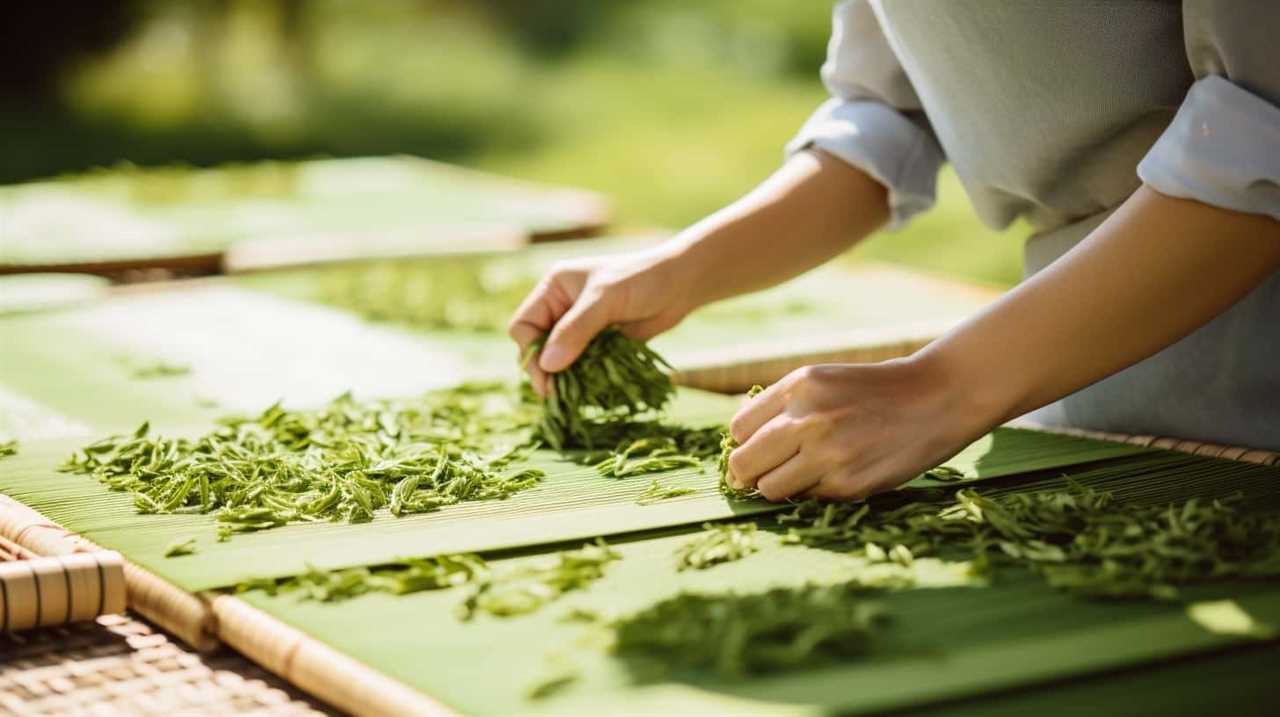
Caffeine Content Differences
As we delve into the topic of caffeine content differences, it’s important to explore how matcha and coffee compare in terms of their antioxidant properties. Both matcha and coffee contain antioxidants, but the levels and types differ. Here are four key points to consider:
- Matcha contains a higher concentration of antioxidants called catechins, which have been shown to have various health benefits.
- Coffee contains antioxidants called chlorogenic acids, which are also beneficial for health but in different ways than catechins.
- The caffeine in matcha is absorbed more slowly by the body compared to the caffeine in coffee, resulting in a more gradual and sustained energy boost.
- While both matcha and coffee can disrupt sleep patterns due to their caffeine content, matcha may have a lesser impact on sleep quality compared to coffee.
Understanding the differences in caffeine absorption and impact on sleep patterns is essential when considering the effects of matcha and coffee on our daily lives.
Now, let’s explore the potential side effects of consuming matcha and coffee.
Potential Side Effects of Consuming Matcha and Coffee
We need to consider the potential side effects of consuming matcha and coffee.
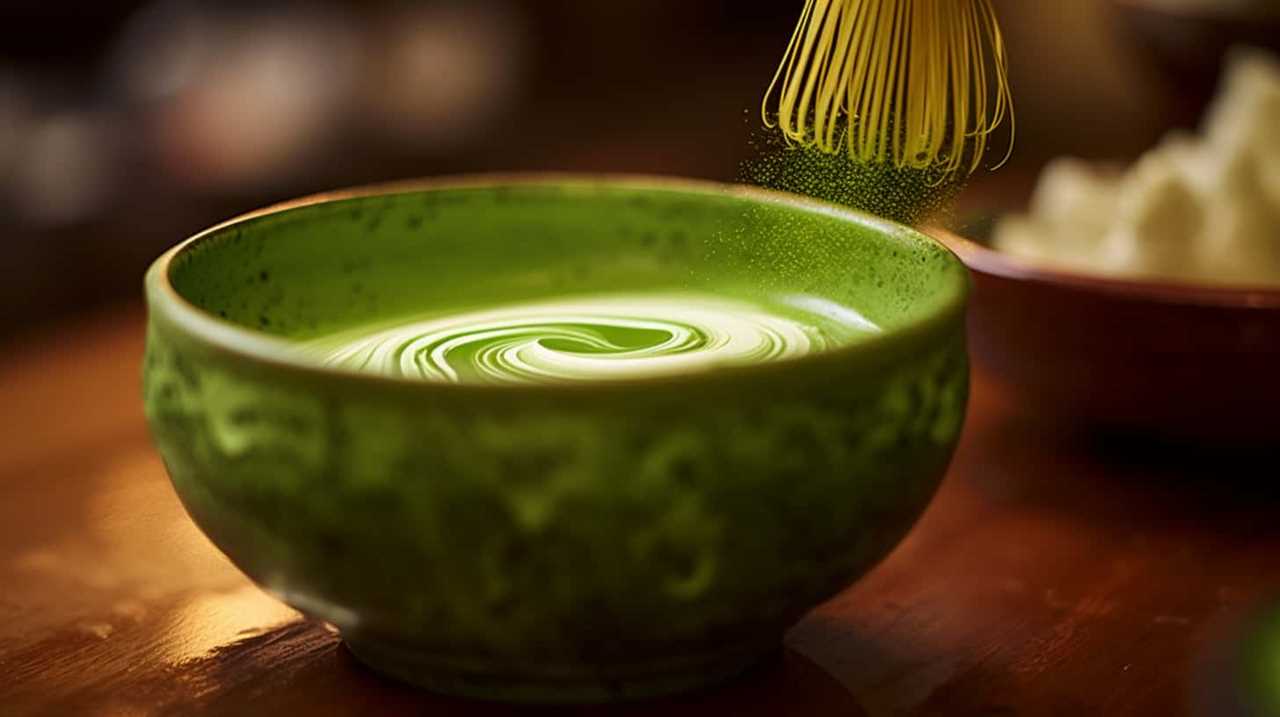
While both matcha and coffee contain caffeine, they also have other compounds that may have different effects on the body.
Matcha is known for its high antioxidant levels, which can have various health benefits. However, consuming excessive amounts of matcha may lead to potential long-term effects such as liver damage and kidney stones.
On the other hand, coffee has been associated with an increased risk of heartburn, insomnia, and anxiety, especially when consumed in large quantities. It’s important to note that individual tolerance to caffeine varies, and some people may be more sensitive to its effects.
As with any dietary choice, moderation is key to avoid potential negative outcomes.

Role in Weight Management
Matcha and coffee both have potential benefits when it comes to weight management.
One of the main points to consider is their calorie-burning properties. Matcha has been shown to increase thermogenesis and fat oxidation, which can help with weight loss.
Additionally, both matcha and coffee have appetite suppression effects and can boost metabolism, further supporting weight management efforts.
Calorie-Burning Properties
While matcha and coffee may share some similarities, it’s important to consider the calorie-burning properties of matcha and its role in weight management.

Matcha has been shown to have metabolism boosting benefits that can aid in weight loss. Here are four key reasons why matcha is effective in burning calories and supporting weight management:
- High levels of catechins: Matcha contains a high concentration of catechins, a type of antioxidant. Catechins have been found to increase thermogenesis, which is the process of burning calories to produce heat.
- Boosts metabolism: Matcha has been shown to boost metabolism, resulting in increased calorie burning throughout the day. This can be especially beneficial for individuals looking to manage their weight.
- Sustained energy: Matcha contains a unique combination of caffeine and other natural compounds that provide a steady release of energy. This can help individuals stay active and burn more calories throughout the day.
- Supports fat oxidation: Research suggests that matcha can increase the rate of fat oxidation, which means it aids in the breakdown and utilization of stored fat for energy.
Considering these calorie-burning properties, incorporating matcha into a balanced diet and active lifestyle may support weight management goals.
Appetite Suppression Effects
When consumed regularly, matcha can help suppress appetite and support weight management goals. Matcha contains a unique combination of catechins, a type of antioxidant, and caffeine, which contribute to its appetite-suppressing effects.
Catechins help to increase satiety and reduce hunger, while caffeine stimulates the central nervous system, resulting in a decrease in appetite. This combination makes matcha a valuable tool in weight management, as it can help to reduce caloric intake and promote feelings of fullness.

Additionally, matcha has been shown to increase thermogenesis, the process by which the body burns calories to produce heat, further contributing to its weight loss benefits.
Incorporating matcha into a balanced diet and exercise routine may help individuals achieve their weight management goals.
Metabolism-Boosting Benefits
How does matcha contribute to boosting metabolism and aiding in weight management?
Matcha is known for its metabolism-boosting benefits, which can play a crucial role in weight management. Here are four key factors to consider:

- High levels of catechins: Matcha contains a high concentration of catechins, which are natural antioxidants that have been shown to increase thermogenesis and stimulate fat oxidation.
- Enhanced energy expenditure: The combination of caffeine and catechins in matcha can help increase energy expenditure and boost metabolism, leading to more calories burned throughout the day.
- Effect on fat metabolism: Matcha has been found to promote the breakdown of stored fat in the body, aiding in weight loss and management.
- Optimal serving size and preparation methods: To fully reap the metabolism-boosting benefits of matcha, it’s important to consume it in the recommended serving size and prepare it using proper methods, such as whisking the powder with hot water.
Understanding these factors can help individuals incorporate matcha into their weight management routine effectively.
Effects on Mental Alertness and Focus
To understand the effects of matcha on mental alertness and focus, we conducted a comprehensive analysis of its impact.
Matcha, a finely ground powdered green tea, has been shown to have positive effects on mood and cognitive performance. The main component responsible for these effects is caffeine, which is found in matcha at lower levels compared to coffee but is released more slowly due to the presence of other compounds.
This slow release of caffeine results in a sustained energy boost without the jittery feeling often associated with coffee. Matcha also contains L-theanine, an amino acid that promotes relaxation and enhances focus.

The combination of caffeine and L-theanine in matcha provides a unique synergy, improving mental alertness and concentration while reducing stress and anxiety. Overall, matcha offers a natural and balanced way to enhance cognitive function and maintain mental clarity.
Influence on Metabolism and Digestion
Matcha has a notable influence on metabolism and digestion. Here are four ways in which matcha can impact these bodily processes:
- Increased calorie burning: Matcha contains catechins, a type of antioxidant, which has been shown to enhance thermogenesis, the process by which the body burns calories.
- Boosted fat oxidation: The catechins in matcha can also promote the breakdown of stored fat, leading to increased weight loss.
- Improved gut health: Matcha contains high levels of dietary fiber, which can support a healthy digestive system and prevent constipation.
- Enhanced nutrient absorption: Matcha contains compounds that can improve the absorption of nutrients, allowing the body to make the most of the food we consume.
Understanding the influence of matcha on metabolism and digestion can help individuals seeking to optimize their weight loss efforts and improve gut health.
Now let’s explore the varieties and flavors available in matcha and coffee.
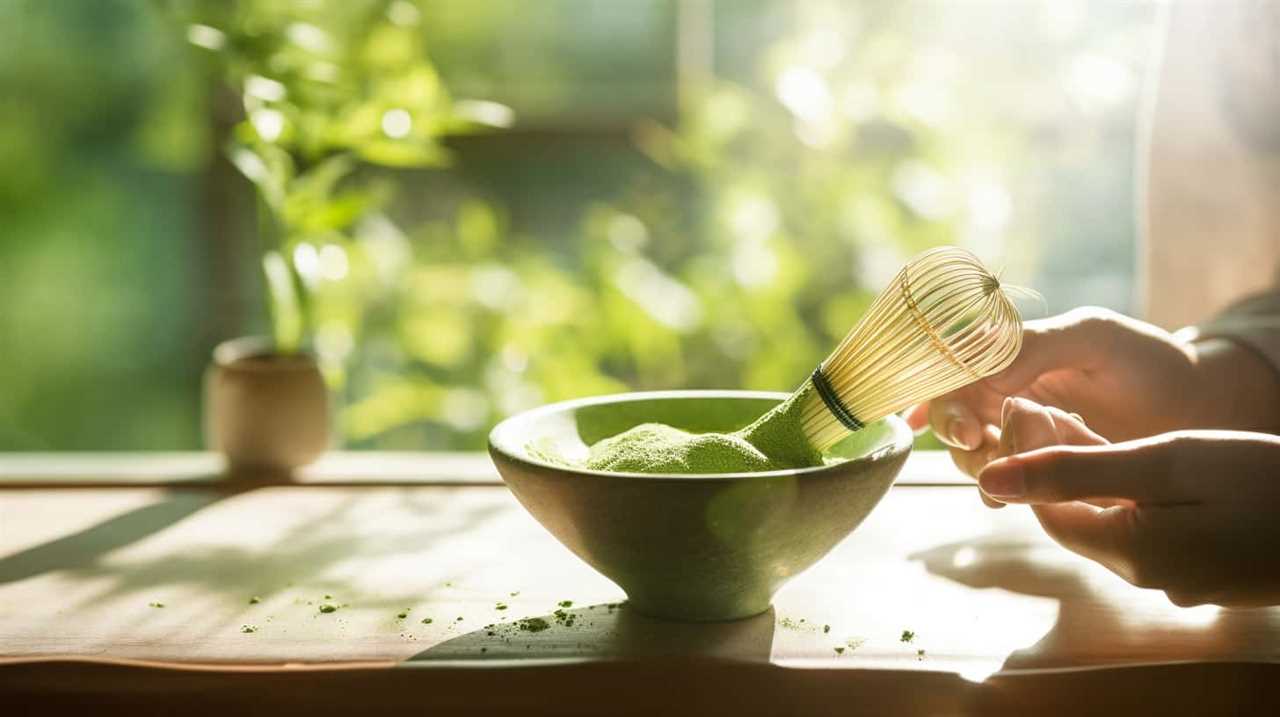
Varieties and Flavors Available in Matcha and Coffee
Now let’s explore the different varieties and flavors we can find in both matcha and coffee.
Matcha comes in various grades, with ceremonial grade being the highest quality and culinary grade being more suitable for cooking. The flavor of matcha can vary depending on the grade, with ceremonial grade having a more vibrant and complex taste compared to culinary grade.
Coffee, on the other hand, offers a wide range of varieties and flavors based on the type of beans used and the brewing method employed. Arabica and Robusta are the two main types of coffee beans, each with its own distinct flavor profile. Brewing methods such as espresso, pour-over, and French press can also influence the taste of coffee.
In terms of variety and flavor comparison, matcha and coffee offer unique experiences to satisfy different preferences.
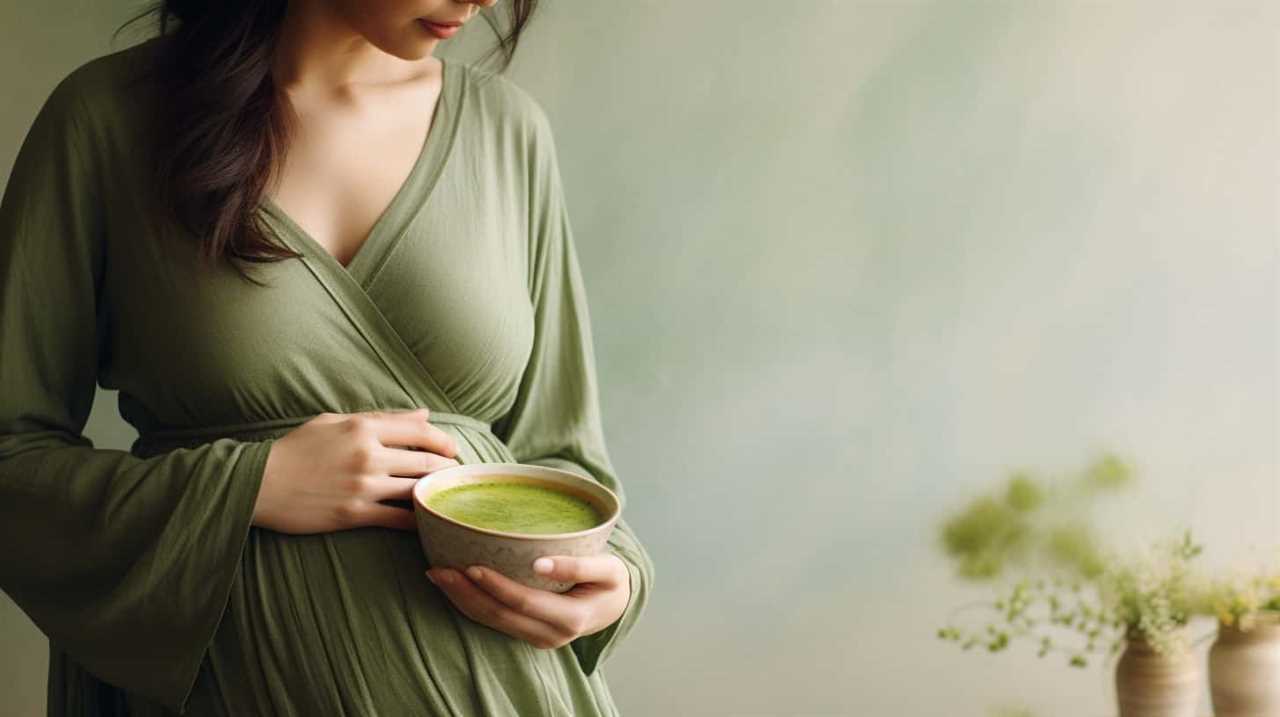
Cultural Significance and Rituals Associated With Matcha and Coffee
As we delve into the cultural significance and rituals associated with matcha and coffee, let’s explore the rich traditions and practices that surround these beloved beverages.
Both matcha and coffee have deep-rooted cultural traditions that have been passed down through generations. Here are four notable aspects of their cultural significance:
- Historical Importance: Matcha has a long and esteemed history in Japanese culture, where it’s often associated with Zen Buddhism and the Japanese tea ceremony. Coffee, on the other hand, has its origins in Ethiopia and has gained cultural significance in various parts of the world, with distinctive brewing methods and rituals.
- Ceremonial Practices: Matcha is renowned for its elaborate tea ceremony, known as ‘chanoyu,’ which involves meticulous preparation and serves as a way to appreciate the beauty and tranquility of the moment. Coffee also has its own set of ceremonial practices, such as the Ethiopian coffee ceremony, which involves roasting, grinding, and brewing coffee beans in a traditional manner.
- Social Bonding: Both matcha and coffee have played a significant role in bringing people together. Whether it’s gathering for a traditional tea ceremony or meeting at a coffee shop for a friendly chat, these beverages have become symbols of social bonding and hospitality in many cultures.
- Symbolic Meanings: Matcha is often associated with purity, harmony, and mindfulness, reflecting the principles of Zen Buddhism. Coffee, on the other hand, is often linked to energy, focus, and productivity. These symbolic meanings have influenced the cultural significance of both beverages and how they’re incorporated into daily rituals and practices.
Understanding the cultural traditions and ceremonial practices associated with matcha and coffee not only enhances our appreciation for these beverages but also provides insights into the diverse cultures and histories that have shaped them.
Incorporating Matcha and Coffee Into Your Daily Routine
Let’s explore how we can incorporate matcha and coffee into our daily routine.

When it comes to matcha, one option is to replace your morning coffee with a matcha latte. This can be done by whisking matcha powder with hot water or milk, and adding sugar alternatives like stevia or honey for sweetness.
Another way to enjoy matcha is by incorporating it into your baking and cooking. Matcha can be used in recipes for cakes, cookies, smoothies, and even savory dishes like matcha-infused pasta.
As for coffee, there are various brewing techniques to explore, such as pour-over, French press, and espresso. Experimenting with different brewing methods can help you discover the flavor profiles that suit your taste preferences.
Whether you choose matcha or coffee, both can be enjoyed as part of a balanced daily routine.

Frequently Asked Questions
Is Matcha or Coffee More Suitable for Someone Looking to Manage Their Weight?
When managing weight, both matcha and coffee can be suitable options. Matcha may aid in weight loss due to its high antioxidant content, while coffee can provide energy and focus. It ultimately depends on personal preference and individual metabolism.
Can Consuming Matcha or Coffee Have Any Potential Side Effects?
Consuming matcha or coffee may have potential health risks and long-term effects. It is important to be aware of these side effects and make informed choices based on individual circumstances and health goals.
How Do the Nutritional Values of Matcha and Coffee Compare?
Matcha and coffee provide different levels of antioxidants. Matcha contains higher amounts of antioxidants compared to coffee. When it comes to boosting energy levels, matcha is a better choice due to its unique combination of caffeine and other natural compounds.
Does Matcha or Coffee Have a Higher Caffeine Content?
Matcha and coffee vary in taste, with matcha offering a unique, earthy flavor. In terms of health benefits, matcha provides antioxidants and amino acids, while coffee may boost metabolism. However, the caffeine content differs, with coffee typically having more.
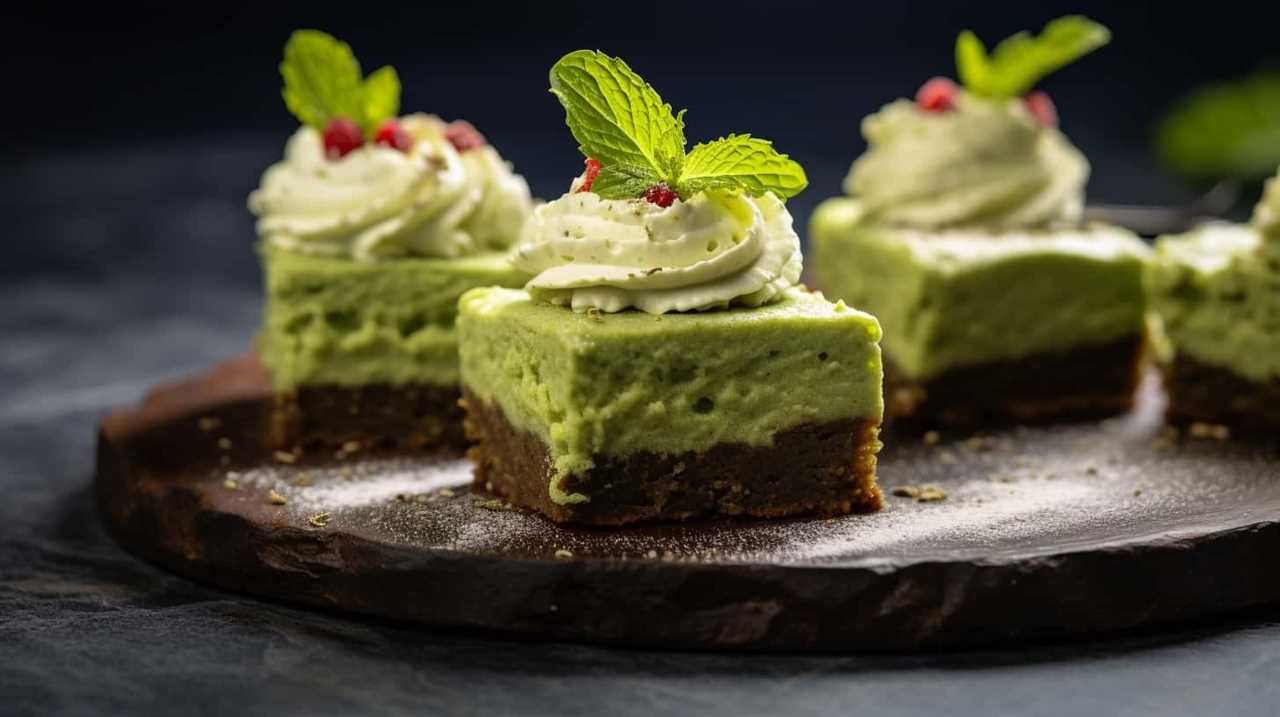
Are There Any Cultural Rituals or Significance Associated With Matcha and Coffee?
Cultural significance surrounds both matcha and coffee, with unique rituals tied to their consumption. Matcha is often used in traditional Japanese tea ceremonies, while coffee holds cultural significance in many Western societies. Both beverages also offer various health benefits.
Conclusion
In conclusion, while matcha and coffee both provide a source of caffeine, they have distinct taste profiles and processing methods.
Matcha is known for its grassy and vegetal flavor, while coffee offers a rich and bold taste.
Additionally, matcha contains a higher level of antioxidants compared to coffee. For example, a recent study showed that regular consumption of matcha improved cognitive function and reduced the risk of heart disease in elderly individuals.
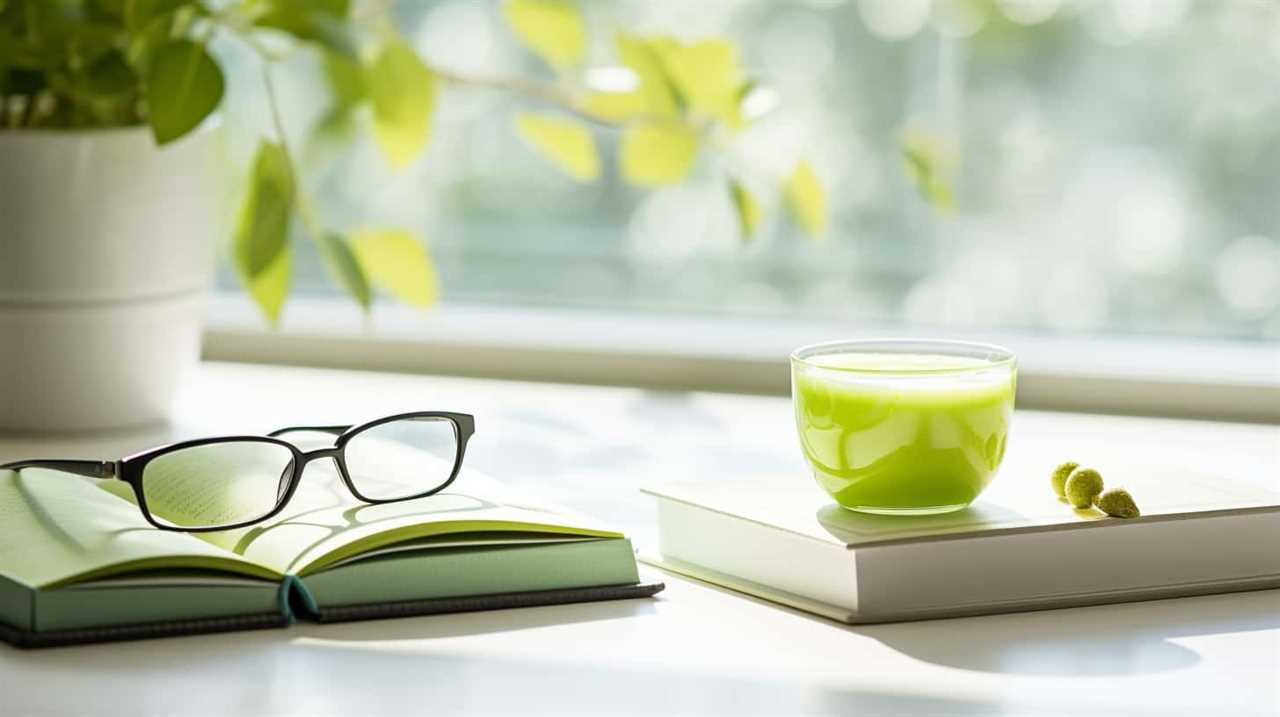
Therefore, incorporating matcha or coffee into your daily routine can offer unique benefits based on your preferences and health goals.
Justin is a seasoned author, coffee and tea enthusiast, and an essential member of the Cappuccino Oracle team. With a keen appreciation for the complexities of coffee, coffee alternatives, and tea, Justin has dedicated his professional career to exploring these realms and sharing his insights with readers worldwide.
Justin’s immersion in the world of coffee, coffee alternatives, and tea began at a young age, kindling a passion that extended beyond mere consumption. This love for these beverages led him to combine his talent for writing with his devotion to coffee and tea, bringing him to Cappuccino Oracle as a dedicated author.
Matcha
Unveiling The Mysteries Of Matcha: Insights On Its Origins, Production, And Quality

Have you ever been curious about the mysteries behind the rich and natural flavors of matcha? If so, get ready to join me on an adventure as we uncover the secrets of matcha, delving into its origins, production, and quality.
As a lover of all things tea, I have delved deep into the world of matcha, immersing myself in its rich history and intricate production process. From the shade-grown tea leaves to the meticulous grinding technique, every step is a labor of love that culminates in the velvety smooth powder we know as matcha.
Join me as we unravel the secrets behind this ancient Japanese tradition and discover why quality is key when indulging in this verdant elixir. We’ll explore the nuances of flavor, the importance of sourcing, and even delve into the fascinating world of other tea varieties.
So grab a cup, sit back, and let’s dive into the captivating world of matcha.
Key Takeaways
- Matcha tea is made from powdered green tea leaves and has a long and labor-intensive production process.
- Premium matcha is made from the first harvest in early spring, using the top 3 sprouts of the tea plant and ground tencha leaves.
- Cheaper matchas may skip some steps in the production process and are more suitable for matcha lattes.
- High-quality matcha is recommended for sparing consumption, as it has a smoother flavor and more health benefits compared to cheaper matchas.
What is matcha?
I’ve learned that matcha is a powdered green tea made from special tea leaves that are shaded before harvest, and it has a long and labor-intensive production process.
There are different types of matcha available, but the premium matcha is made from the first harvest in early spring, using only the top 3 sprouts of the tea plant. The leaves are then steamed, dried, and have their stems removed before being ground into a fine powder using a specialized mill made of granite.
It’s important to note that high-quality matcha is recommended for sparing consumption, as it has a complex production process that results in a smooth flavor. Matcha also offers various health benefits, such as being rich in antioxidants, boosting metabolism, and improving mental alertness.
Production process
The matcha production process involves shading the tea leaves before harvest and selecting the top three sprouts of the tea plant for premium matcha. Shading is a technique used to enhance the flavor and quality of the tea leaves. By covering the tea plants with shade, the leaves produce more chlorophyll and amino acids, resulting in a vibrant green color and a rich, umami taste.
After the shading period, only the top three sprouts of the tea plant are carefully handpicked for premium matcha. These selected leaves, known as tencha leaves, are then steamed, dried, and have their stems removed.
Finally, the tencha leaves are ground into a fine powder using a specialized granite mill. This process results in the smooth and concentrated matcha powder that we enjoy.
Quality and consumption
Let me tell you, indulging in high-quality matcha is like sipping a vibrant green elixir that awakens your taste buds and nourishes your body with its rich flavor and numerous health benefits. Matcha’s health benefits are truly remarkable. Packed with antioxidants, vitamins, and minerals, matcha is known to boost metabolism, enhance focus and concentration, and strengthen the immune system.
But not all matcha is created equal. Different grades of matcha exist, ranging from ceremonial grade to culinary grade. Ceremonial grade matcha is made from the highest quality tencha leaves and has a smooth, vibrant green color and a delicate, umami flavor. It is best enjoyed on its own, whisked with hot water.
On the other hand, culinary grade matcha is more affordable and is suitable for making matcha lattes, smoothies, and baked goods. Although it may have a slightly bitter taste and a duller color, it still provides health benefits.
So, whether you choose to indulge in high-quality ceremonial grade matcha or opt for the more affordable culinary grade, incorporating matcha into your routine is a delicious way to reap its health benefits.
Frequently Asked Questions
What are some popular ways to enjoy matcha besides drinking it as tea?
Besides drinking matcha as tea, some popular ways to enjoy it include indulging in matcha desserts like matcha ice cream, matcha cake, and matcha cookies. Additionally, matcha smoothies are a refreshing and healthy option.
Are there any specific health benefits associated with consuming matcha?
I’m no expert, but matcha is said to have potential health benefits. Some claim it can aid in weight loss due to its high antioxidant content and metabolism-boosting properties. However, more research is needed to confirm these claims.
How does the quality of matcha affect its flavor and overall experience?
The quality of matcha directly affects its flavor and overall experience. Higher quality matcha, made from carefully selected leaves and processed with precision, offers a smoother and more vibrant flavor, while lower quality matcha may have a less appealing taste and color.
Can matcha be used in cooking or baking?
"Where there’s matcha, there’s a way! Matcha can be used in a variety of cooking and baking recipes, adding a vibrant green color and a unique earthy flavor to dishes like matcha desserts."
Are there any specific tips or techniques for properly preparing matcha tea at home?
To properly prepare matcha tea at home, start by sifting the matcha powder to remove any clumps. Then, choose water at around 175°F to 180°F for the best flavor. Gradually add water to the matcha and whisk in a "W" or "M" motion until frothy. Enjoy!
Conclusion
In conclusion, matcha tea is not just a beverage, but a rich and fascinating tradition that has evolved over centuries.
From its origins in Japan to its intricate production process, matcha is a labor of love.
The quality of matcha is crucial, as the steps taken in its production directly impact its flavor and aroma.
Whether you’re a matcha connoisseur or a beginner, there is a matcha tea out there for you.
So, why not indulge in a cup of this vibrant green elixir and experience the magic of matcha for yourself? It’s a journey worth embarking on!
Arf, an author and an innovative enthusiast of coffee, coffee alternatives, and tea, plays a crucial role as a contributor to the esteemed Cappuccino Oracle platform. Renowned for his curiosity and passion for these captivating beverages, Arf has carved out a unique space for himself in the world of exploration and writing. He realized that coffee, coffee alternatives, and tea are not mere drinks to keep one awake, but universes of flavors and stories waiting to be explored.
Arf’s articles for Cappuccino Oracle blend meticulous research with personal experiences, providing readers with an in-depth understanding of various types of coffee, coffee alternatives, and tea, along with their unique characteristics, cultures, and histories. His honest reviews and engaging narratives guide readers on their own journeys, helping them discover their preferences and find their perfect brew.
Matcha
Unveiling The Truth Behind Starbucks’ Matcha: A Disappointing Blend

Being a lover of tea, I was eager to sample Starbucks’ matcha beverages, anticipating a flavorful and genuine taste. However, to my dismay, I found that it was a subpar mixture of inexpensive green tea powder and an excessive amount of sugar. This was a stark contrast to the customary matcha experience that I had grown accustomed to.
The use of low-quality matcha by Starbucks is driven by the need for mass production and a consistent taste across all locations. But in this pursuit, they have sacrificed the true essence of matcha. Authentic matcha production involves meticulous steps to ensure a high-quality and flavorful product, steps that Starbucks seems to skip.
The result is a matcha latte packed with 32 grams of sugar, equivalent to a can of soda, and a whopping 240 calories. It’s time to unveil the truth behind Starbucks’ matcha and explore better options for a truly satisfying tea experience.
Key Takeaways
- Starbucks uses a cheap green tea powder for their matcha drinks, which may not even be considered matcha.
- The cheap matcha powder is mixed with a lot of sugar, negating the health benefits and undermining the quality of the tea.
- Starbucks’ matcha latte contains a high amount of sugar, similar to a can of soda, and has a significant number of calories.
- To have a better matcha experience, it is recommended to explore premium, first harvest matcha made by talented farmers in Japan and to try different matcha options to find preferred taste.
What is Starbucks Matcha?
Starbucks Matcha is a cheap green tea powder mixed with a high amount of sugar, which not only undermines the health benefits of matcha but also fails to deliver the natural, great-tasting flavor of authentic matcha tea.
The ingredients used in Starbucks matcha include low-quality green tea powder that is likely produced on a large scale. Unlike traditional matcha production methods, Starbucks skips certain steps to save time and money. These steps, such as shading the tea plants to reduce bitterness and selecting the top leaves for their flavor and nutrients, are crucial in creating high-quality matcha.
Instead, Starbucks opts for a blend of cheap green tea powder mixed with sugar, resulting in a dull and bitter flavor. This disappointing blend of ingredients does not live up to the standards of true matcha tea.
Quality vs. Cheap Matcha
Indulging in high-quality matcha is like savoring a delicate melody that dances on your taste buds, while settling for cheap matcha is akin to a discordant symphony that leaves a bitter aftertaste. When it comes to matcha, quality matters. Traditional matcha production is an art that requires time, patience, and attention to detail. The importance of shading the tea plants, selecting the top leaves, and using a stone mill to grind the leaves into a fine powder cannot be overstated. These steps not only enhance the flavor but also preserve the health benefits of matcha. High-quality matcha is rich in antioxidants, boosts metabolism, and promotes a sense of calm. On the other hand, cheap matcha often lacks these qualities as it skips crucial steps and is mixed with sugar and other additives. Don’t settle for a subpar matcha experience; choose high-quality matcha for its exceptional taste and health benefits.
| Traditional Matcha Production |
|---|
| Shading the tea plants |
| Selecting the top leaves |
| Grinding with a stone mill |
The importance of traditional matcha production cannot be overstated. These steps not only enhance the flavor but also preserve the health benefits of matcha. High-quality matcha is rich in antioxidants, boosts metabolism, and promotes a sense of calm. On the other hand, cheap matcha often lacks these qualities as it skips crucial steps and is mixed with sugar and other additives. Don’t settle for a subpar matcha experience; choose high-quality matcha for its exceptional taste and health benefits.
Recommendations for Better Matcha
Exploring different matcha options can lead to a better matcha experience. When it comes to matcha, not all options are created equal. While Starbucks may offer a convenient matcha latte, there are alternative options that provide a more authentic and higher quality experience.
Premium matcha, specifically first harvest matcha, is made by talented farmers in Japan and can be enjoyed plain, without the need for excessive sugar or additives. By choosing premium matcha, you can reap the full benefits that matcha has to offer, such as its high antioxidant content and potential health benefits.
Additionally, exploring different types of matcha, such as Japanese black tea, can expand your taste palate and introduce you to new and exciting flavors. So, why settle for a disappointing blend when there are better matcha options out there waiting to be explored?
Frequently Asked Questions
How is Starbucks matcha different from traditional matcha?
Starbucks matcha differs from traditional matcha in terms of quality and taste. One interesting statistic is that Starbucks’ matcha latte contains 32 grams of sugar, similar to a can of soda, which undermines the health benefits of matcha.
What are the health benefits of matcha and how do they differ between Starbucks matcha and premium matcha?
The health benefits of matcha include high levels of antioxidants, increased energy, and improved focus. However, Starbucks matcha quality is compromised due to the use of cheap powder mixed with sugar, negating these benefits.
Can you customize the sweetness level of Starbucks matcha drinks?
Yes, you can customize the sweetness level of Starbucks matcha drinks. They offer popular matcha drink variations like matcha latte and matcha frappuccino, allowing customers to choose the amount of sweetener they prefer.
Are there any alternative options for matcha drinks at Starbucks?
Yes, there are alternative options for matcha drinks at Starbucks. However, it’s important to note that the taste may not be comparable to traditional matcha. Exploring different matcha options and Japanese black tea can provide a better experience.
What are the steps involved in producing high-quality matcha and how does Starbucks’ matcha production differ?
Starbucks’ matcha production process differs from traditional matcha production in Japan. High-quality matcha involves shading the tea plants, selecting the top leaves, steaming, drying, and grinding them. However, Starbucks skips these steps, resulting in a lower quality and less authentic matcha experience.
Conclusion
In conclusion, after delving into the truth behind Starbucks’ matcha, it’s clear that their blend falls short of expectations. The use of cheap green tea powder mixed with excessive sugar dilutes any potential health benefits and fails to deliver an authentic matcha experience.
To truly enjoy the rich and flavorful taste of matcha, it’s recommended to explore premium, first harvest options crafted by skilled Japanese farmers. Don’t settle for subpar matcha; treat yourself to a tea experience that’ll leave your taste buds dancing with delight.
Arf, an author and an innovative enthusiast of coffee, coffee alternatives, and tea, plays a crucial role as a contributor to the esteemed Cappuccino Oracle platform. Renowned for his curiosity and passion for these captivating beverages, Arf has carved out a unique space for himself in the world of exploration and writing. He realized that coffee, coffee alternatives, and tea are not mere drinks to keep one awake, but universes of flavors and stories waiting to be explored.
Arf’s articles for Cappuccino Oracle blend meticulous research with personal experiences, providing readers with an in-depth understanding of various types of coffee, coffee alternatives, and tea, along with their unique characteristics, cultures, and histories. His honest reviews and engaging narratives guide readers on their own journeys, helping them discover their preferences and find their perfect brew.
Matcha
The Ultimate Guide To Using Chashaku: Your Matcha Essential

Being a lover of matcha, I am aware that the crucial factor in achieving the perfect matcha bowl is the equipment we utilize. When it comes to preparing matcha, there is one tool that is particularly essential: the chashaku.
This bamboo spoon, with its elegant design and precise measurements, is the secret weapon of matcha lovers worldwide. In this ultimate guide, I will take you on a journey through the history and evolution of the chashaku, and show you how to use it like a pro.
From its origins as a metal or ivory scoop to its modern-day incarnation in bamboo, the chashaku has come a long way. With its 48° bend and 18mm length, it effortlessly scoops the perfect amount of matcha from its container.
So grab your chashaku and get ready to elevate your matcha game to new heights. Let’s dive in and discover the wonders of this matcha essential.
Key Takeaways
- Chashaku is a bamboo spoon used to scoop matcha powder in the Japanese tea ceremony and by matcha lovers worldwide.
- Chashaku is one of the three important tea utensils used in the tea ceremony and is about 18mm in length with a 48° bend at the end for scooping.
- Chashaku is made of bamboo to avoid negative reactions with matcha powder and is a great measurement tool for matcha powder.
- Two scoops of chashaku is the standard amount for a bowl of matcha tea, and it is easy to maneuver in matcha tins or natsume due to its small size.
What is Chashaku?
Chashaku is a bamboo spoon used to scoop matcha powder, and it’s one of the three important tea utensils used in the Japanese tea ceremony.
Made from a single piece of bamboo, this elegant tool has a long history dating back to the Muromachi period in Japan. Originally crafted from metal or ivory, chashaku evolved to be made of bamboo due to its natural properties and to avoid any negative reactions with matcha powder.
The design of chashaku is both functional and beautiful, with a length of about 18mm and a 48° bend at the end for easy scooping. There are different styles of chashaku scoops, each with its own unique shape and characteristics. The back of the chashaku has a rough texture, while the face is smooth and sleek.
Whether you’re a matcha lover or a tea ceremony enthusiast, using a chashaku adds a touch of authenticity and tradition to your matcha preparation.
History and Evolution
During the Muromachi period in Japan, the chashaku spoon evolved from being made of metal or ivory to its current bamboo form, which is about 18mm in length and has a 48° bend at the end for easier scooping. The history and evolution of the chashaku is a testament to its significance in Japanese tea ceremonies and its cultural importance in matcha preparation.
| The significance of chashaku in Japanese tea ceremonies | The cultural importance of chashaku in matcha preparation |
|---|---|
| Chashaku is one of the three important tea utensils used in the tea ceremony. | Chashaku is a great measurement tool for matcha powder. |
| Chashaku originated in Japan during the Muromachi period. | Chashaku’s small size allows for easy maneuvering in matcha tins or natsume. |
| Originally made of metal or ivory, chashaku evolved to be made of bamboo. | Chashaku is made from a single piece of bamboo and shaped with a bend for the scoop. |
| Chashaku is made of bamboo to avoid negative reactions with matcha powder. | The back of chashaku has a rough texture, while the face is smooth and sleek. |
The chashaku’s role in Japanese tea ceremonies cannot be understated. It is one of the three essential utensils used in the tea ceremony, alongside the chawan (tea bowl) and chasen (tea whisk). The chashaku’s small size and precise measurement make it the perfect tool for scooping matcha powder. Its evolution from metal or ivory to bamboo shows the cultural importance placed on this utensil. The chashaku’s design, with its gentle bend and smooth face, allows for easy and graceful scooping of matcha. Using the chashaku is not only practical but also a way to honor the centuries-old tradition of matcha preparation.
How to Use Chashaku
To use the chashaku, I simply hold it like a pencil and dip the scoop into the matcha container. Then, I carefully lift the chashaku scoop out and place it over the matcha bowl to dump the powder.
It’s a simple and elegant technique that ensures the perfect amount of matcha every time.
But did you know that there are alternative ways to use the chashaku? Some matcha lovers prefer to use a teaspoon or a regular spoon to scoop their matcha powder. While these alternatives may work in a pinch, they don’t offer the same precision and authenticity as the chashaku.
The chashaku’s unique design and size make it the ideal tool for measuring matcha powder. Plus, using the chashaku adds a traditional touch to the matcha preparation process, enhancing the overall experience.
So why settle for anything less? Embrace the chashaku and elevate your matcha game to the next level.
Frequently Asked Questions
What are the different types of materials used to make chashaku besides bamboo?
There’s something truly magical about the chashaku, the bamboo spoon that gracefully scoops matcha powder. While bamboo is the traditional material, chashaku can also be made from metal or ivory, although these alternatives are less common.
Can chashaku be used to scoop other powders besides matcha?
Yes, chashaku can be used to scoop other powders besides matcha. However, it is primarily designed for scooping matcha powder and is most commonly used in Japanese tea ceremonies. To properly clean and care for a chashaku, it is recommended to wipe it with a dry towel or tissue to avoid water damage. The chashaku is a versatile tool with different uses in the tea ceremony, making it an essential item for matcha lovers.
How long does a chashaku typically last before it needs to be replaced?
A chashaku typically lasts for a long time, but the lifespan can vary depending on the material. Bamboo chashaku is the most common and durable option, while metal or ivory may wear down over time. Proper care involves cleaning with a dry towel or tissue to avoid water damage.
Can chashaku be used with different types of matcha bowls or is it specific to a certain style?
Absolutely! Chashaku can be used with various types of matcha bowls, adapting to different styles. Its small size and unique design make it perfect for scooping matcha powder and adding a touch of elegance to your matcha preparation.
Are there any alternative utensils that can be used in place of chashaku for scooping matcha powder?
Yes, there are alternative utensils for scooping matcha powder, such as a teaspoon or a small spoon. However, using a chashaku has its benefits. Its unique design allows for precise measurements and easy maneuvering in matcha tins.
Conclusion
In conclusion, using chashaku isn’t just a practical way to measure and scoop matcha powder, but it’s also an essential tool for embracing the art and tradition of the Japanese tea ceremony.
While some may argue that using a regular spoon can achieve the same result, chashaku offers a unique experience that connects us to centuries of tea culture. Imagine holding the slender bamboo spoon, feeling the weight of tradition in your hand, and delicately scooping the vibrant green matcha powder.
It’s a sensory journey that brings us closer to the beauty and mindfulness of matcha preparation. So, embrace the chashaku, and let it elevate your matcha experience to new heights.
Arf, an author and an innovative enthusiast of coffee, coffee alternatives, and tea, plays a crucial role as a contributor to the esteemed Cappuccino Oracle platform. Renowned for his curiosity and passion for these captivating beverages, Arf has carved out a unique space for himself in the world of exploration and writing. He realized that coffee, coffee alternatives, and tea are not mere drinks to keep one awake, but universes of flavors and stories waiting to be explored.
Arf’s articles for Cappuccino Oracle blend meticulous research with personal experiences, providing readers with an in-depth understanding of various types of coffee, coffee alternatives, and tea, along with their unique characteristics, cultures, and histories. His honest reviews and engaging narratives guide readers on their own journeys, helping them discover their preferences and find their perfect brew.
-

 Americano4 weeks ago
Americano4 weeks agoHow to Make Americano With Moka Pot
-

 Americano2 weeks ago
Americano2 weeks agoHow to Make Korean Iced Americano
-

 Americano4 weeks ago
Americano4 weeks agoHow to Make Americano With Bialetti
-

 Americano4 weeks ago
Americano4 weeks agoHow to Make Dutch Bros Americano
-

 Americano1 week ago
Americano1 week agoHow to Make an Iced Americano With Nespresso
-

 Americano2 weeks ago
Americano2 weeks agoHow Many Shots of Espresso for 16 Oz Americano
-

 Americano4 weeks ago
Americano4 weeks agoHow to Make a Hazelnut Americano
-

 Turmeric Tea1 week ago
Turmeric Tea1 week agoTurmeric Saffron Tea

















